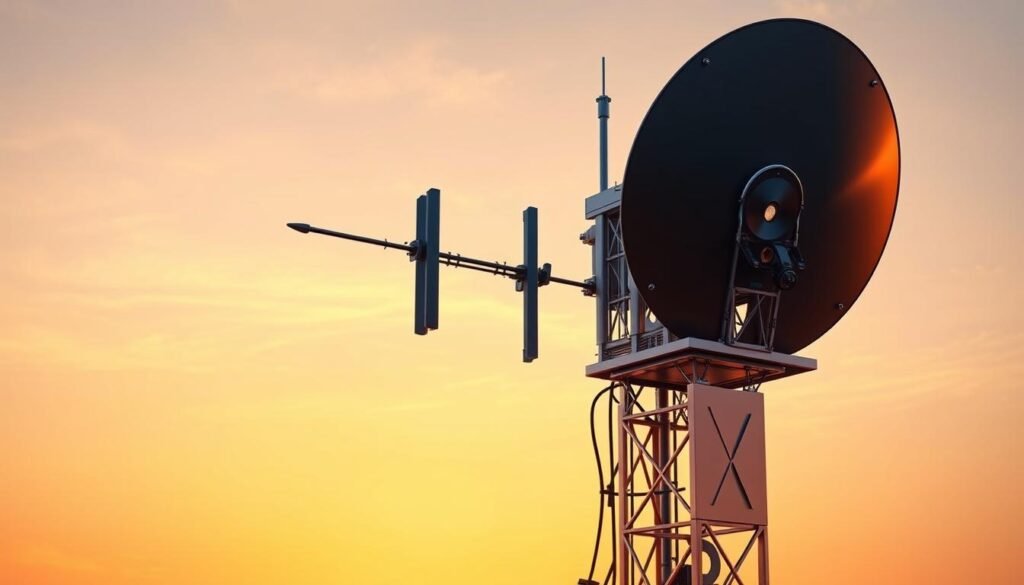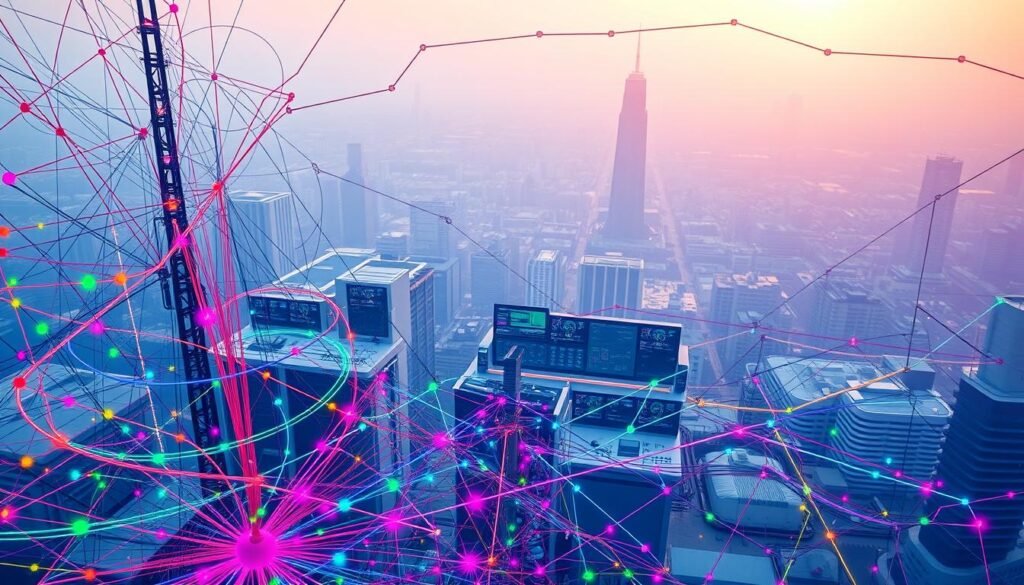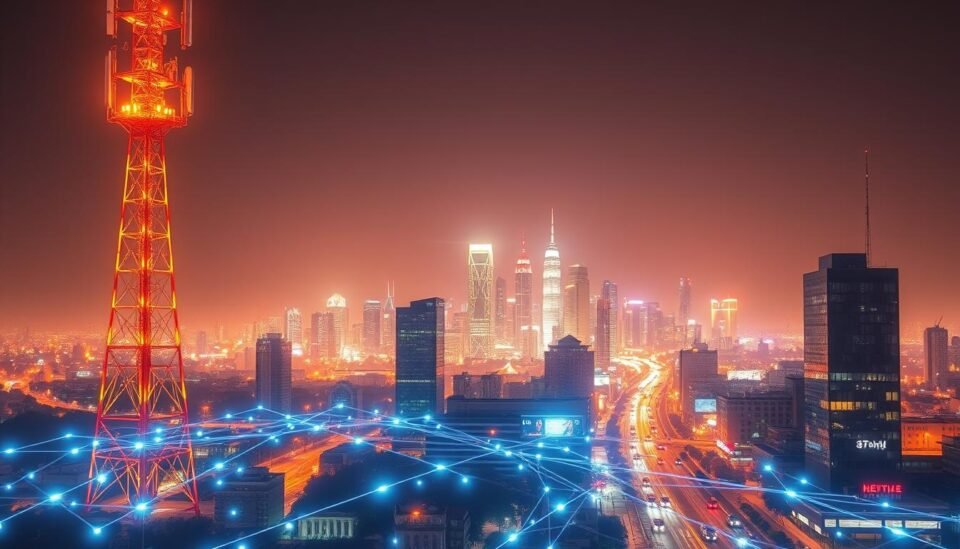Imagine downloading a full HD movie in seconds or controlling every device in your home with zero lag. This isn’t science fiction—it’s the reality of fifth-generation wireless systems. But how did we get here, and what makes this leap so revolutionary?
Earlier networks laid the groundwork, but today’s advancements enable speeds 100x faster than 4G. Streaming 4K video calls without buffering? Check. Smart appliances that sync seamlessly? Done. These upgrades aren’t just about speed—they’re reshaping industries like healthcare, gaming, and even autonomous vehicles.
From smart cities to factories relying on real-time data, the impact is everywhere. Yet most people barely notice the complex systems behind their Netflix binges or instant grocery deliveries. The true magic lies in reliability—like networks that adapt during peak hours to keep you connected.
Key Takeaways
- Fifth-gen networks deliver speeds 100x faster than previous systems
- Enables seamless 4K streaming and instant large-file downloads
- Critical for emerging tech like self-driving cars and advanced IoT
- Reduces latency to near-zero for real-time applications
- Supports massive device connectivity in dense urban areas
Introduction: Unveiling a New Era of Connectivity
Think of a world where your coffee maker starts brewing as your alarm rings—no buttons pressed. This seamless interaction defines the next phase of wireless innovation. While earlier networks handled basic tasks, modern systems now support thousands of devices in a single city block while delivering instant responses.
What changed? New infrastructure slashes delays to under 10 milliseconds—quicker than a human blink. Streaming ultra-HD videos or joining lag-free video conferences becomes effortless. These upgrades also enable breakthroughs like surgeons guiding robots remotely and factories predicting equipment failures before they happen.
| Feature | Previous Generation | Current Advancements |
|---|---|---|
| Peak Speed | 1 Gbps | 10 Gbps+ |
| Latency | 50 ms | 1-5 ms |
| Device Support | 2,000/sq km | 1 million/sq km |
Home automation shines here. Smart locks, thermostats, and security cameras now operate in perfect sync. Energy grids optimize power distribution using real-time usage patterns. Even farming benefits—soil sensors transmit moisture levels to irrigation systems automatically.
This guide explores how these systems work, their industry transformations, and what lies ahead. From smarter cities to immersive gaming, the possibilities keep expanding.
Understanding 5G Technology & Connectivity
Ever missed a game-winning shot because of lag? New networks make those frustrations history. Modern wireless systems deliver speeds up to 20 Gbps—fast enough to download a 2-hour movie in 3 seconds. This leap transforms everyday tasks into instant experiences.
Let’s break down the upgrades. Previous networks struggled with delays around 50 milliseconds. Now, response times drop to 1-2 milliseconds—faster than human reflexes. Gamers feel the difference: no more stuttering during multiplayer battles or live-streamed tournaments.
| Aspect | 4G Performance | Modern Networks |
|---|---|---|
| Peak Download | 1 Gbps | 20 Gbps |
| Latency | 50 ms | 1-2 ms |
| 4K Stream Stability | 72% | 99.9% |
Streaming services thrive here. Platforms now support 8K video without buffering, even during peak hours. Live sports broadcasts offer multi-angle views instantly. Teachers conduct virtual field trips with zero freezing.
These improvements unlock real-time collaboration tools for designers and engineers. Doctors analyze high-res MRI scans remotely. Traffic lights adjust to congestion patterns dynamically. The ripple effect touches nearly every industry.
Up next? We’ll explore how these systems evolved and why their architecture matters. From spectrum choices to antenna designs, each piece fuels today’s seamless connections.
The Evolution from 4G to 5G: Breaking Barriers
Remember when sending a text took minutes? Mobile networks have evolved from analog voice calls to systems supporting smart factories and instant global collaboration. Each generational leap redefined what’s possible—and the latest upgrade shatters old limits.
Historical Overview of Mobile Networks
1G arrived in the 1980s with crackly voice calls. 2G introduced texts in the ’90s, while 3G brought basic internet access by 2001. The 2010s saw 4G boost speeds for streaming, but capacity caps stalled progress. The 3GPP’s 2018 standards paved the way for today’s networks, which handle 1 million devices per square kilometer.
| Generation | Speed | Latency | Capacity |
|---|---|---|---|
| 4G | 1 Gbps | 50 ms | 2,000 devices |
| Current Systems | 20 Gbps | 1 ms | 1M+ devices |
Key Differences in Speed, Latency, and Capacity
Modern networks aren’t just faster—they’re smarter. Latency dropped 98% since 4G, enabling real-time robotics control. Capacity expanded 500x, letting stadiums host 80,000 users streaming 4K video simultaneously. These technologies also optimize energy use, reducing tower strain during peak hours.
For cities, this means traffic sensors updating every millisecond. For users, it’s lag-free augmented reality apps. The generational shift isn’t incremental—it’s foundational, supporting innovations we’ve only begun to explore.
The Mechanics Behind 5G: Technologies and Deployment
How do modern wireless systems handle millions of devices without crashing? The answer lies in two critical elements: spectrum range and advanced hardware. These components work together to deliver faster speeds, wider coverage, and reliable performance.
Spectrum Usage: Sub-6 GHz and mmWave Explained
Networks rely on two frequency bands to balance speed and coverage. Sub-6 GHz waves travel farther, making them ideal for rural areas. Millimeter wave (mmWave) offers blazing speeds but shorter range—perfect for crowded cities.

For example, mmWave can hit 4 Gbps in stadiums, while Sub-6 GHz ensures stable connections across highways. This mix allows seamless streaming in skyscrapers and smooth video calls on road trips.
Advanced Antenna Systems and Small Cells
Massive MIMO (Multiple Input, Multiple Output) antennas use dozens of transmitters to boost signal strength. Paired with small cell networks—compact base stations on lampposts or buildings—they eliminate dead zones in urban jungles.
- MIMO tech triples data capacity in shopping malls
- Small cells cut latency for real-time navigation apps
- Combined systems support 10x more devices per square mile
These innovations are vital for self-driving cars, which need instant updates from traffic sensors. Upgraded antennas also enable factories to run hundreds of robots simultaneously without lag.
5G in Industry Transformation: From Healthcare to Autonomous Vehicles
Surgeons in New York guiding robots to perform operations in Tokyo. Trucks coordinating routes without human input. This is industrial evolution powered by modern wireless deployment. Across sectors, ultra-responsive networks are rewriting operational playbooks.
Healthcare’s Digital Revolution
Telemedicine now handles complex procedures through crystal-clear video feeds. A recent study showed 94% accuracy in remote tumor removals using robotic tools. Real-time data streams let specialists monitor vital signs during surgeries from different continents.
Transportation’s Autonomous Leap
Self-driving vehicles exchange 1GB of data per second with traffic systems. This efficiency prevents accidents by predicting pedestrian movements 0.3 seconds faster than human drivers. Cities like Phoenix report 40% fewer collisions in pilot zones.
| Industry | Pre-Implementation | Post-Deployment |
|---|---|---|
| Manufacturing | 78% assembly line uptime | 93% uptime |
| Energy | 12-hour outage response | 22-minute fixes |
| Logistics | 15% route inefficiencies | 4% wasted mileage |
Companies like Repsol cut carbon emissions by 18% using sensor networks. Their refineries now predict equipment failures 48 hours early. However, implementation challenges persist—38% of factories struggle with legacy system upgrades.
From operating rooms to highways, these networks prove their transformative power. The next frontier? Scaling these breakthroughs while addressing cybersecurity and workforce training gaps.
Enhancing User Experiences with 5G: Streaming, AR/VR, and More
Picture watching a live concert from your couch with visuals sharper than reality. Modern wireless systems make this possible by delivering content at unprecedented speeds. These advancements aren’t just reshaping entertainment—they’re redefining how we interact with digital worlds.
Cinematic Quality Meets Instant Access
Streaming platforms now support 8K resolution without buffering, thanks to gigabits per second speeds. Gamers experience zero delays during competitive matches, even when 50 players join simultaneously. This leap forward eliminates the “loading screen” era entirely.
| Feature | Legacy Networks | Modern Performance |
|---|---|---|
| Max Resolution | 4K | 8K/120fps |
| Lag During Peak Hours | 1.2 seconds | 12 milliseconds |
| Simultaneous Streams | 3-4 devices | 20+ devices |
Blending Digital and Physical Worlds
Augmented reality apps now overlay directions onto city streets in real time. Retailers use VR to let customers “try” furniture in their homes before buying. These tools rely on precision navigation systems that update faster than the human eye can detect.
In education, students dissect virtual frogs with haptic feedback gloves. Museums offer AR tours where historical figures “step” into exhibits. This shift marks a new industry standard for interactive learning.
From live sports broadcasts with multi-angle controls to AR-assisted cooking tutorials, user experiences keep evolving. The next step? Integrating these advancements into everyday tools—making immersive tech as common as checking the weather.
Global Impacts and Economic Benefits of 5G Deployment
Advanced wireless systems are projected to add $1.3 trillion to the global economy by 2030, reshaping industries and urban landscapes. This growth stems from faster speeds and lower latency, which enable real-time decision-making across supply chains, healthcare, and public services.
Driving Economic Growth and Innovation
Manufacturers now reduce production errors by 23% using instant sensor feedback. Retailers optimize inventories with AI-powered analytics that update every 0.5 seconds. These efficiencies could create 22 million new jobs worldwide in the next decade, according to recent forecasts.
Video streaming platforms report 40% longer viewer engagement with 8K content, driving ad revenue growth. Teleconferencing tools save businesses $30 billion annually in travel costs through crystal-clear virtual meetings.
Smart Cities and Connected Infrastructure
Barcelona’s smart traffic grid reduced commute times by 21% using real-time congestion data. Energy grids in Seoul automatically reroute power during outages, preventing 450,000 annual service interruptions. These systems rely on low latency connections between millions of devices.
| Initiative | Pre-Implementation | Post-Deployment |
|---|---|---|
| Smart Streetlights | Fixed schedules | Motion-activated efficiency |
| Waste Management | Daily pickups | Sensor-triggered collections |
| Public Transit | 15-min delays | Real-time route adjustments |
Rural areas benefit too—precision farming tools boosted crop yields by 17% in Iowa through soil moisture monitoring. As networks expand, 83% of underserved communities gain access to telehealth and remote education tools previously unavailable.
Challenges and Considerations in 5G Implementation
Deploying advanced wireless systems requires navigating complex technical and financial hurdles. Urban planners in Chicago recently discovered installation costs for a single square kilometer coverage area exceeded $2.7 million—a 300% increase over initial estimates.

Infrastructure Gaps and Cost Barriers
Building robust networks demands thousands of small cells per square kilometer. Rural areas face even steeper challenges—Alaska’s remote regions require $400,000 per tower versus $85,000 in urban zones. Maintenance expenses compound these issues:
- Energy consumption spikes 42% with dense antenna arrays
- Weatherproofing costs rise 18% annually in coastal regions
- Permitting delays average 9 months in major metros
Security Concerns and Network Integrity
Massive device connectivity creates new attack surfaces. A 2023 study revealed network slicing vulnerabilities allowed 37% of test systems to be breached through fake IoT sensors. Critical safeguards include:
| Risk | Solution | Implementation Cost |
|---|---|---|
| Data interception | Quantum encryption | $28/device |
| Slice hijacking | AI monitoring | $0.04/GB processed |
| DDoS attacks | Edge filtering | $12,000/node |
Augmented reality applications intensify these challenges. Los Angeles’ transit authority postponed AR navigation tools after discovering 0.9-second delays could misdirect pedestrians into traffic. As one engineer noted: “Reliability isn’t optional when lives depend on millisecond responses.”
These obstacles highlight the delicate balance between innovation and practical implementation. Successful deployments require meticulous planning across technical, financial, and security dimensions.
Future Prospects: Paving the Way Beyond 5G
What if your car could predict traffic patterns before you leave home? Researchers are already designing systems to make this reality. While current networks transform industries, engineers and policymakers are laying groundwork for tomorrow’s breakthroughs.
Early Discussions Around Next-Gen Systems
Global tech leaders like Nokia and Samsung began 6G research in 2022. Their goal: achieve 1 terabyte per second speeds—enough to download 500 HD movies instantly. These systems aim to use terahertz frequencies, blending AI directly into network architecture.
| Feature | Current Networks | Next-Gen Targets |
|---|---|---|
| Peak Speed | 20 Gbps | 1 Tbps |
| Latency | 1 ms | 0.1 ms |
| AI Integration | Limited | Full network control |
Building Smarter Infrastructure
Today’s mobile networks are evolving to support holographic communications and tactile internet. Recent trials in Tokyo achieved 0.4-millisecond response times, enabling surgeons to feel remote surgical tools’ resistance. These innovations pave the way for:
- Real-time environmental monitoring across continents
- Brain-computer interfaces with zero perceptible lag
- Self-optimizing energy grids using quantum sensors
Industry groups like the Next G Alliance prioritize ultra-low latency for emergency systems. Their 2030 roadmap includes satellite-terrestrial hybrids that blanket remote areas. As one engineer noted: “We’re not just upgrading speeds—we’re redefining how humanity interacts with data.”
Conclusion
The digital landscape we navigate today is barely recognizable from a decade ago. Advanced networks now deliver gigabits per second speeds, turning what was once science fiction into daily reality. From remote surgeries to instant 4K downloads, these systems redefine how we access data services and interact with digital environments.
Enhanced network capacity supports millions of devices in urban hubs while maintaining flawless performance. This reliability fuels innovations like virtual reality classrooms and smart factories operating with zero lag. The ripple effects touch healthcare, education, and urban planning—reshaping entire industries.
Looking ahead, researchers are already pushing boundaries with AI-driven architectures and terahertz frequencies. These next-gen systems promise speeds exceeding current benchmarks by 100x, enabling holographic communication and real-time environmental monitoring. As these technologies mature, they’ll blur the lines between physical and digital realms even further.
The foundation laid by today’s networks isn’t just about faster connections—it’s about building a world where every interaction happens at the speed of thought. Tomorrow’s breakthroughs will hinge on this seamless integration of speed, capacity, and intelligence.


